- Home
- John Norman
Kur of Gor Page 3
Kur of Gor Read online
Page 3
Life is very real where they live it, at the edge of a sword.
The reader may be interested in obtaining an account, however superficial, of certain events antecedent to the incarceration of the individual, Tarl Cabot.
It is rumored that within recent years certain tumults or transitions have taken place in the realm of Priest-Kings. I do not know whether that is true or not. Who is to say what thrones may have been toppled, what crowns seized? Surely such things, coups, insurrections, fatalities, suppressions, and such, are not unknown even within the benign civilizations of the habitats. And are they not useful in subverting stagnation, and improving bloodlines? And if such things occurred, it is not impossible that they may have had a role in this business. Again, one does not know. On the other hand, such things, such conjectured events, bloody or otherwise, are not strictly germane to this history.
The individual, Tarl Cabot, had, it seems, upon occasion proved to be of some value to Priest-Kings. In some eyes, though not in his, we may conjecture, he was even taken as an agent of Priest-Kings. And certainly, whether this be so or not, one may well suppose that any behavior of his which might have been deemed counter to the interests or policies of those mysterious beings would not have been likely to be generously countenanced.
We can understand these things.
In this respect I do not think we are so unlike the Priest-Kings, whoever, or whatever, they may be.
In the north of Gor, in its polar regions, inhabited sparsely by tribes of humans known as the Red Hunters, recognizable by the small blue spot at the base of their spine, it is said that he, this Tarl Cabot, once encountered a great war general of the Kurii, Zarendargar, whose name, for convenience, we have transliterated into phonemes hopefully accessible to at least some readers of this tale, certainly in this translation. Colloquially, doubtless with a certain crudity, he, Zarendargar, was spoken of as “Half-Ear.” And, of course, few of the Kurii who ascend high in the rings will be without certain blemishes. A certain area of the polar region was at that time being used as staging area, under the command of the aforementioned Zarendargar, a staging area with munitions and such, for an attack on the Sardar enclave, destined to suddenly, decisively, and irremediably terminate the rule of Priest-Kings, destroying them in their own most-favored haunts or lairs. It had taken better than a century for this materiel, bit by bit, to be secretly assembled. One can well understand then its preciousness and importance to the Steel Worlds, its relevance to their projects, and such. The staging area, however, was destroyed, and somehow, in some way, Tarl Cabot seems to have been involved in its destruction. It was supposed at the time that Zarendargar was destroyed in the explosion, or conflagration, or such. But this turned out to be mistaken. When it became clear that Zarendargar had survived the destruction of the staging area, a death squad was dispatched from the Steel Worlds to hunt him down and kill him, for he had, after all, failed the people. The policies and decisions connected with the transmission of the death squad were controversial, incidentally, in the councils of the Steel Worlds, and the decree of termination, some months later, would be rescinded. This, of course, could not have been anticipated by the personnel of the Death Squad. Representatives of the Death Squad contacted Samos of Port Kar, clearly an agent of Priest-Kings, and Tarl Cabot, for assistance in hunting down and executing Zarendargar. It was assumed naturally that this assistance would be readily tendered for Zarendargar was well understood to be significant amongst the Kurii and a relentless, dedicated, and dangerous foe of Priest-Kings. The putative location of the at-that-time-fugitive Zarendargar was the vast prairies of the Gorean Barrens. Tarl Cabot, however, instead of lending his assistance to the Death Squad, himself entered the dangerous Barrens to warn Zarendargar and, if possible, protect him. This effort, of course, was not only contrary to the desires of the Death Squad, but, too, seemed clearly to be an act not in the best interests of Priest-Kings. On whose side, so to speak, was this mysterious, unpredictable, ungoverned Tarl Cabot? Was he an agent of Priest-Kings? Was he an agent of Kurii? If he was an agent, it seems he was his own agent, or an agent of honor, for, long ago, it seems, he and Zarendargar had shared paga.
In any event Tarl Cabot, having returned from the Barrens, and having learned later of his putative outlawry, resolved to leave the maritime city of Port Kar, only to return when it might be safe to do so, this intelligence to be gathered from agreed-upon secret signals to be displayed on the holding of his friend, Samos, of Port Kar.
Tarl Cabot remained at large, so to speak, for some time.
The surveillance of Priest-Kings is rather efficient, as we have reason to know, but it is also, as we have reason to know, far from perfect, particularly so in recent years. Perhaps this has to do with transitions or dislocations in the Sardar, such as have been occasionally rumored. But perhaps not. It is hard to know. Surely small ships, at least, manned by humans, have frequently enough, of late, penetrated the atmosphere of Gor. Many, apparently detected, have been ignored. Others, pursued, have eluded their pursuers. I personally suspect that this lapse of attentiveness or this seemingly tolerant permissiveness, or this seeming lack of zeal, on the part of Priest-Kings, and their ships, presumably mostly automated and remotely controlled, has less to do with technological limitations than with some reordering of priorities in the Sardar, perhaps even with an acceptance of the general harmlessness of the ships involved, and a disinterest in their common cargoes. It may be a simple matter of balancing costs. It is hard to know. Our information is clearly incomplete, and conjectural. On the whole, Priest-Kings seem tolerant of other life forms, their activities, partialities, and such. Indeed, they may even look with approbation, given the apparent current infrequency of their voyages of acquisition, or collection, on the introduction of additional human life forms to the world. To be sure, the chains of human females brought to Gor might conceivably, eventually, in some centuries, depress certain relevant markets. At that point presumably only carefully selected, high-quality merchandise would be brought to her shores. But one knows little about such things.
Eventually, however, we may conjecture that the presence of Tarl Cabot was detected. This may have been a matter of chance. On the other hand, he may have been sought for ardently, perhaps because of the heinousness of his offense, his treasonous concern for the welfare of an enemy. Perhaps he was to be used as an example. It is not known.
We now find him, at any rate, naked, in his container, in perfect custody.
He is completely helpless, and fully at the mercy of his captors, or keepers. In this respect he is not much unlike the human females whom men of his sort, on Gor, are wont to keep for their work and pleasure. They, of course, are not at the mercy of captors or keepers, but of owners, and masters. They are owned, you see. They are properties, possessions. Also, they are legally, and in the eyes of all, animals. And as such, as any other form of such an animal, an owned animal, for example pigs or verr, they are subject to barter, exchange, gifting, sale, and such. They are spoken of as slaves.
Whereas Kurii may own humans, and several do, they do not think of them as “slaves,” no more than men of Gor would think of their verr and kaiila as slaves, or those of, say, Earth, would think of their pigs and horses, or cattle, as slaves. They are simply domestic animals. The slave, then, from the Gorean view, is a domestic animal, but a particular type of domestic animal, one different, obviously, from other types, such as the verr or kaiila. Thus, not all domestic animals are slaves, but all slaves are domestic animals. Too, many Gorean men seem to be as fond, or even more fond, of their slaves than of, say, their sleen or kaiila, animals commonly much more expensive. To be sure, they master them with firmness, and do not let them forget that they are only slaves. That is seemingly the Gorean way.
Tarl Cabot was not certain how long he had been incarcerated in the heavy, narrow, glassine container. Nor are we. It was perhaps some days, or weeks. Given the absence of clocks, the unknown periodicity of feedings, if they wer
e periodized, the nature of the soporific gas, and such, it would be hard to say.
The gravity in the venue, the Prison Moon, was currently indexed to that of its mother world, Gor, to which it was a satellite. We are not clear, given the small size of the moon, a mere several pasangs in diameter, how this was managed. It is done differently, certainly, and perhaps more primitively, in the cylinders and spheres, in the Steel Worlds. The capabilities of the Priest-Kings, whoever or whatever they may be, are not well understood. Certainly it would not do to underestimate either their power, resolve or sagacity. Four times the Kurii erred in this regard, and their mistakes were costly. That such, the Priest-Kings, have form, and can interact with matter, however, seems obvious. The Prison Moon, for example, seems to make that clear, as it is obviously an artificial moon, with its architectural steel, its absorbing cells, its focusing and power mirrors, its shielding, and such, one perhaps once used for purposes of extra atmospheric observation, perhaps low-gravity experiments, and such. It seems unlikely that it was originally designed as a facility for the retention and storage of life forms, or, if you like, as a maximum-security prison for, say, particular prisoners.
Shortly before the unexpected disruption, one which seems to have taken even Priest-Kings unawares, this seemingly adding indisputable and welcome evidence as to their limitations and vulnerability, two human females were entered into the container in question.
It is clear they were females, as the human species is characterized by an obvious and radical sexual dimorphism.
It is seldom difficult to tell a human female from a human male.
Their sexes are quite different.
Too, as is common in the human species, these two females were considerably smaller than the average male, and considerably weaker.
That tends to be a characteristic of the human female.
Size and strength are common features of the human male, and accordingly the human female, smaller and weaker, often seeks to secure and protect herself within the shelter of these features.
These two females were in some respects similar, and in other respects quite different. Both were, as we understand it, of the sort which would be attractive, even excruciatingly so, to a human male. One was darkly pelted, with brown eyes, and the other was lightly pelted, or blondishly pelted, with blue eyes. Both were young, the darkly pelted one perhaps a bit older than the other. Each was, as tests later demonstrated, healthy and fertile. Each, too, was characterized by delicate, even exquisite, features, of a sort so clearly different from the coarse type found commonly in the human male. This has perhaps to do with several millennia of sexual selection. Too, both were, as humans understand such things, deliciously figured, this, too, doubtless having to do with generations of sexual selection. Indeed, the figures of both were nearly, if not quite, at what merchants in these matters refer to as the optimum block measurements for their size and weight. Block measurements, taken presale, are commonly, and in some cities this is required by law, included in a female's sales information. They are often available, as well, before the female is put on the block, hence the name ‘block measurements'. Needless to say, too, given the female's subjection to severe regimens of rest, diet, and exercise, it is almost assured, as is desired, by attention to these “block measurements,” that she will come to the block in excellent condition, healthy, vital, and well-curved. That is the way she is to be sold. She is, after all, merchandise, and, hopefully, good merchandise. Too, we may suppose, being healthy, each had the needs and desires of a healthy female, and, considering their selection, may have had these drives, and such, in an acute fashion, even uncomfortably so, which would render them particularly sexually vulnerable. Gorean slavers, for example, often pay close attention to such things. After all, most men buy women for pleasure.
Both of these females were of the sort, then, which, on Gor, would be of interest to buyers. They were typical of the females found in Gorean markets, and were perhaps, we suspect, given their insertion into the container, somewhat above average. Presumably both would have gone for a good price, and certainly so if they had been brought within suitable block measurements, to which, as noted, they were already in close approximation.
At the time that these females were entered into the small compass of the container Tarl Cabot was sedated, and thus unaware of their insertion into his small world.
They, too, at the time, must have been sedated.
The corridor was doubtless pressurized prior to their insertion into the container, and then returned to its near-vacuum condition.
This was done shortly prior to the disruption, as well.
That was seen to.
I have mentioned that the females were quite different, and you must understand that these differences pertained to far more than their pelting, eye color, and such. Before I discourse, however briefly, on certain of these differences, I mention something you, or some of you, may find of interest. That is that the human female, and the male, as well, for that matter, is relatively hairless. This may be an adaptation to facilitate heat loss in long-distance pursuit and pack hunting, or, again, it may have to do merely with preferences involved in sexual selection, or both. It is hard to know about such things. A consequence of this lack of hair, or fur, is that the species, in its wanderings and migrations, certainly into colder areas, must clothe itself. This seems to have been done first by taking the skins and fur of other animals, with which the Nameless One, if it was concerned at all with such matters, had refused to provide them, and later particularly by the utilization of plant fibers, and such. Clothing also, it seems, interestingly, is often worn by the species even when it is not climatologically indicated, and, indeed, sometimes when it is even uncomfortable. It can serve, of course, as a decoration, a symbol of status, a concealment of provocative or vulnerable areas, and so on. The harnesses and accouterments of the Kurii are presumably not dissimilar, at least in some of these respects. Female slaves may or may not be clothed, of course, as the master pleases. This increases their sense of vulnerability, and dependence. The female slave is seldom unaware of her condition but, too, interestingly, seldom does she wish to be. Her bondage may be her terror, but more often it is her meaning and joy. This apparently has to do with a variety of genetic antecedents and endowments, dispositions and complementarities, selected for in the long and interesting course of human evolution. One does not note with surprise that such complementarities should occur in a species so sexually dimorphic. Indeed, one would expect them. When they are clothed, the female slaves, it is often minimally, and provocatively. This reminds them, too, of their bondage, and is sexually stimulatory not only to the masters but to the chattels, as well. The pelting of the Kur female, of course, on the other hand, is thick, abundant, rich, and glossy, and, in season, heavy. How could a human female even begin to compare with a Kur female in beauty, let alone in power or ferocity? Her fangs for example, are negligible. The human female could not, for example, in three or four Ihn, tear loose a limb from a terrified, struggling tabuk.
But now to the more important aspects which characterized the new additions to Tarl Cabot's container.
Neither, in effect, at least as yet, was Gorean.
One, the darkly pelted female, was from an area on Earth not unfamiliar to Tarl Cabot himself. It is called an England, of which there are apparently more than one. He himself, we have learned, was from a seaport in that country or world, called Bristol. He attended an institution or institutions in this England, institutions of what they think of as “higher learning.” But one suspects they are, as yet, as a species, scarcely capable of what one might call “lower learning.” This supposed learning, as it is spoken of, took place, it seems, in a place where cattle were once wont to ford. That seems a strange place to build. At least they have a world. The female, who is intelligent and quite articulate, at least until she was taught silence and the appropriateness of petitioning for an opportunity to speak, was also a supposed learner, or student
, in that very same place, though not exactly in the same place. These things are hard to understand. Her background was rich and her family had standing in that world. She would have counted as having been of the high classes. But I do not think her family earned its class or wealth honestly or honorably, for example through the rings, but then that is not unusual amongst humans. She was a student of “anthropology.” Here the translator is less than helpful. It is presumably a sort of history or literature, perhaps having to do with chants and songs. Perhaps it has to do with knowing the traditions, but the traditions are different in diverse worlds. How could one know them all? Too, they may guard their traditions. Is it appropriate to inquire into such things? If dogs or pigs had such studies, their anthropologies, or such, who could find them of interest? Perhaps a biologist? Perhaps a dog or pig? But such things are now behind the female. Her life has changed. It is interesting to note that her background is in some respects similar to that of Tarl Cabot. That may be important. She was apparently obtained by Priest-Kings for some purpose or another. I suspect the reason. We may learn later. In any event, she was not acquired by our human confederates, though it is also clear, from their assessments, that she was quite capable of satisfying their usual criteria. Indeed, I have been informed that had they been aware of her she would have been entered on their acquisition lists. In such a case she would have eventually found herself on a Gorean slave block, being auctioned to the highest bidder.
Accordingly one gathers she is a most excellent example of human female, highly intelligent, healthy, nicely curved, and quite beautiful, at least for the species, and acutely sexually needful. Too, she is tormented by the restless, uneasily sensed suspicions and yearnings, so alien to her acculturation, which afflict so many such women, longings which frighten her, and into which she fears to inquire. These longings have to do with her nature, and her identity, with what she is, most profoundly, and what she should be, absolutely. They are the longings of an acutely needful but as-yet unmastered slave.

 Avengers of Gor
Avengers of Gor Kajira of Gor coc-19
Kajira of Gor coc-19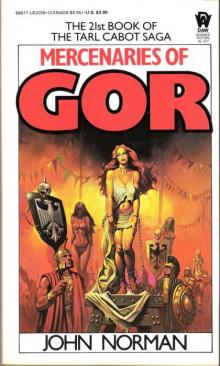 Mercenaries of Gor coc-21
Mercenaries of Gor coc-21 Witness of Gor coc-26
Witness of Gor coc-26 Witness of Gor
Witness of Gor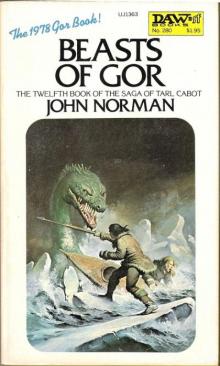 Beasts of Gor coc-12
Beasts of Gor coc-12 Rebels of Gor
Rebels of Gor Mariners of Gor cog[oc-30
Mariners of Gor cog[oc-30 The King th-3
The King th-3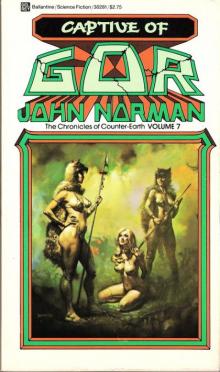 Captive of Gor coc-7
Captive of Gor coc-7 The Captain th-2
The Captain th-2 Vagabonds of Gor coc-24
Vagabonds of Gor coc-24 Explorers of Gor
Explorers of Gor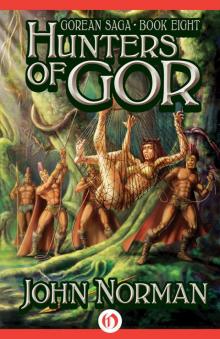 Hunters of Gor
Hunters of Gor The Chieftan th-1
The Chieftan th-1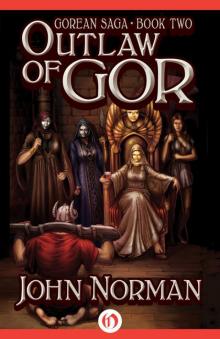 Outlaw of Gor
Outlaw of Gor Priest-Kings of Gor coc-3
Priest-Kings of Gor coc-3 Norman Invasions
Norman Invasions Marauders of Gor coc-9
Marauders of Gor coc-9 Kur of Gor coc-28
Kur of Gor coc-28 Time Slave
Time Slave The Chieftain
The Chieftain Kur of Gor
Kur of Gor Rogue of Gor
Rogue of Gor The Totems of Abydos
The Totems of Abydos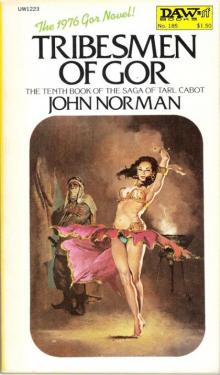 Tribesmen of Gor coc-10
Tribesmen of Gor coc-10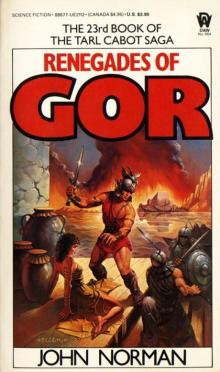 Renegades of Gor coc-23
Renegades of Gor coc-23 The King
The King Tarnsman of Gor
Tarnsman of Gor The Usurper
The Usurper Captive of Gor
Captive of Gor Conspirators of Gor
Conspirators of Gor Smugglers of Gor
Smugglers of Gor Savages of Gor
Savages of Gor Savages of Gor coc-17
Savages of Gor coc-17 Fighting Slave of Gor
Fighting Slave of Gor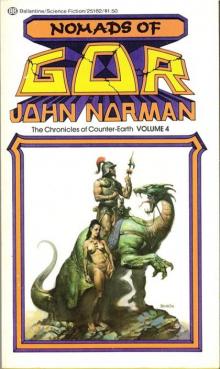 Nomads of Gor coc-4
Nomads of Gor coc-4 Fighting Slave of Gor coc-14
Fighting Slave of Gor coc-14 Swordsmen of Gor cog[oc-29
Swordsmen of Gor cog[oc-29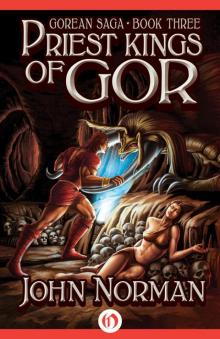 Priest-Kings of Gor
Priest-Kings of Gor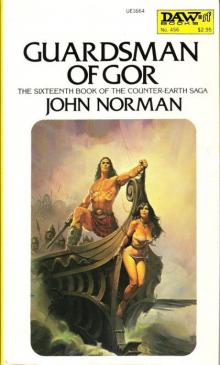 Guardsman of Gor coc-16
Guardsman of Gor coc-16 Hunters of Gor coc-8
Hunters of Gor coc-8 Dancer of Gor coc-22
Dancer of Gor coc-22 Prize of Gor coc-27
Prize of Gor coc-27 Conspirators of Gor cog[oc-31
Conspirators of Gor cog[oc-31 Slave Girl of Gor
Slave Girl of Gor Explorers of Gor coc-13
Explorers of Gor coc-13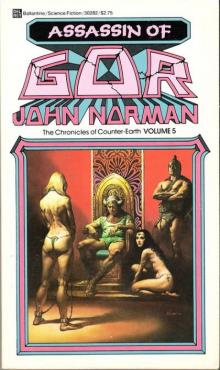 Assassin of Gor coc-5
Assassin of Gor coc-5 Raiders of Gor coc-6
Raiders of Gor coc-6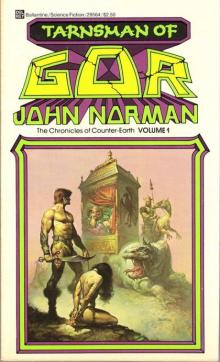 Tarnsman of Gor coc-1
Tarnsman of Gor coc-1 Dancer of Gor
Dancer of Gor Outlaw of Gor coc-2
Outlaw of Gor coc-2 Guardsman of Gor
Guardsman of Gor Beasts of Gor
Beasts of Gor Ghost Dance
Ghost Dance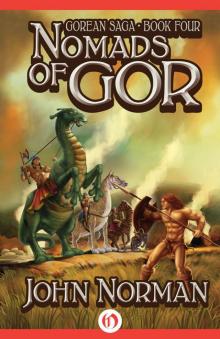 Nomads of Gor
Nomads of Gor Prize of Gor
Prize of Gor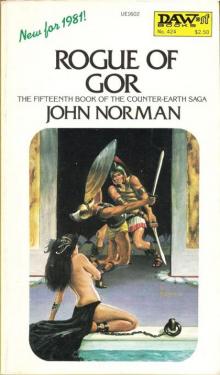 Rogue of Gor coc-15
Rogue of Gor coc-15 Swordsmen of Gor
Swordsmen of Gor